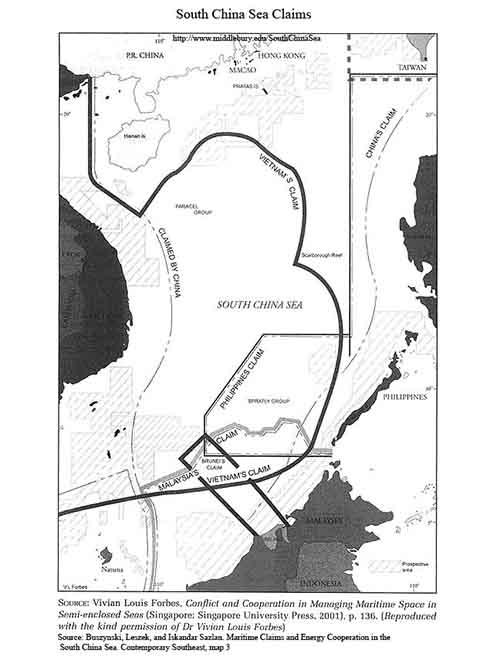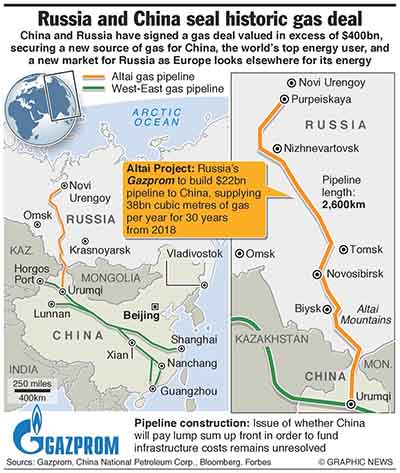A rising China and a receding United States are now fighting for dominance in one of the most strategically important areas in the world. China becomes a formidable competitor of the US in every possible field be it economics, military, social or power projection. A US-China security competition is going to be the main feature in the geopolitical landscape of East Asia. It is high time to ask, what options does China or the US have?
The US is still dominant across the board, while China is increasingly catching up in the economic sector, the US still holds China by the balls in military terms with an army and navy that can completely destroy the Chinese navy anywhere except for China’s littoral zone and in Taiwan and North Korea. Given that the US has fairly well-entrenched alliances with regional powers such as Vietnam, Japan and South Korea, the United States is well primed to face up against the Chinese competitor.
Develop a NATO-like alliance in East Asia
This would have sounded like a far more realistic prospect as little as a decade ago had the US not monumentally blundered in the Middle East and in Afghanistan.
The United States would probably have it best if they could create a coalition of states in China’s periphery that would help contain China both in military and economic standpoint, however, this sort of alliance becomes increasingly unlikely by the day simply by virtue of the sheer economic reliance of many of these countries on China; a situation the US cannot hope to replace.
Australia is practically dependent on the Chinese consumption, Indonesia and Malaysia which are traditionally pro-US have been drifting towards the neutral side due to Chinese investments, large-scale economic integration, as well as unpopular US moves such as recognizing Jerusalem as the capital of Israel (something that China capitalized on by refusing to recognize Jerusalem as Israel’s capital).
Japan, South Korea, Taiwan and the Philippines are far more reliable in this aspect, however, even the Philippines could possibly defect to neutrality. Under the new leader Duterte, relations with China are on an upswing trajectory as China has been lavishing the Philippines with investments.
The Asian-NATO concept is becoming increasingly unlikely to happen as Trump is actively refusing economic integration with these countries, much to the pleasure of the Chinese who are now increasingly gobbling the spare space left by a receding US. Although it is unlikely that the US will completely lose these countries, it seems more and more improbable that the United States will be able to form a strong NATO-like alliance in Asia, because the Chinese economic integration is forcing countries on China’s periphery to rethink about joining an anti-China coalition. Particularly, countries that do not have active border disputes or have relatively in-active border disputes with China such as Malaysia, Thailand, Laos, Cambodia and Indonesia.
The other problem with attempting to form an Asian NATO is the fact that countries in the region also have disputes amongst themselves. Vietnam for example, despite constantly proclaiming itself to be a victim in the face of Chinese aggression, has a maritime claim that is extraordinarily large and overlaps with the Philippines, Malaysia, Taiwan, Brunei and China.

The US, as a result, cannot completely integrate Vietnam into a cohesive alliance structure because it would make the US to side with either their traditional Filipino friends or the Vietnamese. Washington may have to choose in between Malaysia, the Philippines and Vietnam which would leave ample room for China to exploit the divide.
Strengthen relations with other anti-China powers in Asia
The US is scooping up whatever left of Asia. They already have Japan and South Korea in their pockets as historical issues prevent these countries from aligning with China.
Vietnam has seen an uptake in relations with the United States, as it continues to scoop up anti-China nations that are not in China’s economic pocket. Taiwan is another case as well as India.
The main problem with this approach is that it may alienate countries that have historical problems with each other for example, Cambodia and Laos are now firmly in the Chinese camp as a result of the US re-alignment to Vietnam.
The US shows no grievances with this approach at all as the United States will lose countries such as Pakistan, Cambodia and Laos (possibly even Thailand if the military stays in power). The US has decided that it is worth sacrificing the relations with these countries to get Vietnam and India to its side.
Taiwan is a complex case because China considers Taiwan a part of its territory. As a result, the US must tread carefully with Taiwan. However, the United States is trying hard to keep Taiwan in its pocket. Taiwan is also an integral part of the American strategy to dominate the first island chain.
If the Chinese forcibly reunify Taiwan, (which they can, if the US is forced to stay out, read my analysis here: Rinat Abdekadir’s answer to For how many days could Taiwan resist if China unexpectedly invaded Taiwan?) the US will lose a lot of leverage over China as Chinese submarines will become a formidable threat to US bases in the Pacific and Okinawa. It will also improve China’s power projection capabilities in the surroundings of the Japanese held Pinnacle islands (Diaoyu/Senkaku islands). The US position in Taiwan is uncertain, if you had asked me as little as a decade ago I would’ve seen no way for Taiwan to be forcibly reunified unless the US completely collapses but the situation has changed a lot. Taiwan is getting increasingly vulnerable to a Chinese invasion.
Support separatist movements in Tibet and Xinjiang
Tibet and Xinjiang are two separatist-minded elements in China. They are both minority groups and distinct from the Han Chinese. The US has supported these elements most of the time to divert Chinese attention away from East Asia to these regions.
The main problem with this approach is that there is no way to effectively recruit insurgents in those regions as Pakistan is no longer friendly to the United States. Tibet is too mountainous and remote; Xinjiang is sealed off by Russian aligned Central Asian states and Pakistan Which will not support America in this endeavor. India will not likely support these movements as China could retaliate by funding Kashmiri or Northeast Indian separatists from Pakistan and Burma. The US is unlikely to use this approach unless a drastic change in the geopolitical environment occurs.
The Chinese are not hopeless; in fact, they are pushing back in ways that might completely change the game.
Develop a land route to the Middle East for importing oil
CPEC and BRI are China’s current ongoing efforts to expand into the Indian Ocean region to open up an alternative route to the Strait of Malacca for importing oil from the Middle East. This is actually quite a smart geopolitical maneuver because if it works, the US navy will become a white elephant. The US will no longer be certain of the fact that it can successfully cut off the Chinese oil supply if China gets the majority of its oil from Russia, Central Asia, Iran and Saudi Arabia by land route.
This approach, however, alienates India as it views itself as the rightful hegemon of South Asia. CPEC also runs through the disputed territory in Kashmir which India claims, as well as China entrenching itself in India’s sphere of influence (Pakistan, Nepal, Bhutan, Sri Lanka) which will make India’s attempts at forcing them into submission much harder. As a result, India has aligned itself with the US. China doesn’t have much of a choice though, there are only two countries which connect China to the Indian ocean (Pakistan and India), India is not going to help China in this endeavor as there are historical tensions with China over the 1962 war, existing disputes and past Indian support of Tibetan separatists. So China is essentially forced to pick Pakistan as a partner.
Put the US navy’s dominance over East Asia in doubt
Carrier killer missiles are just one example of these weapons that the Chinese are making, as well as the stationary defense systems in the South China Sea islands. These weapons introduce a new equation into the game if they work as they should be the US Navy will find itself cornered if a war breaks out.
Spratly and Paracel islands in the South China Sea can host extensive naval and air facilities which give the US Navy a lot less room to maneuver freely. If the PLAN (PLA Navy) is able to challenge the US carriers in a battle, the United States’ leadership will find it much harder to garner support for a war against China.
Begin establishing better relations with South American countries
The US has had hegemony over the entire American continent for a long time, however, there are a few countries that still resist tooth and nail against the US such as Cuba, Venezuela, Brazil and so on. China and Russia can use those nations to keep America busy in Latin America. China is trying to have better relations with Nicaragua, Venezuela and Argentina.
Will China succeed in this endeavor? As of now, it looks unlikely that South American regional powers will jump on the Chinese boat because the US has spent so much time in the past 50 years essentially transforming almost all of South America into its backyard. Practically, all South American countries are dependent on the United States of America. However, Geopolitics is quite unpredictable; the situation may change in the near future. If China manages to break Washington’s stranglehold on South America then China will have far more leverage over the US.
Build a more cohesive alliance with Russia
Traditional geopolitical reasoning dictates that Russia will side with America, as China is the rising power and Russia’s sphere of influence and China’s overlap. However, the Russians due to historical reasons and resentment over the expansion of NATO to Russia’s borders are not very keen on siding with the US in this matter. Russo-Chinese relations are on an upswing right now, although China has past grievances with Russia for stealing Outer Manchuria. However, among the major Western powers, Russia was by far the friendliest; it kicked out the Japanese and established the territorial integrity of China.

Russia gives China a lot more room, as China now has a reliable source of oil from a friendly state. Russia is now supplying oil to China. This will again, reduce Chinese reliance on US dominated straits and allow China a lot more breathing room. The Chinese have definitely succeeded in this regard.
As of now, it is not very easy to predict who will win in the long run. I am fairly pessimistic about the future of US-China relations because the US seems hell-bent on preventing China’s rise as a major power. Although based on Chinese history, I find it quite unlikely that China would want a worldwide hegemony like the US has. States tend to make choices based on the safest possible route, the US may be forced into a security dilemma of either letting China gain hegemony over East Asia or causing a war to prevent it.

The writer is an amateur economist and a lover of history and geopolitics. He is a Kazakh Chinese from Xinjiang and Rinat currently writes extensively about China and geopolitics on Quora.

